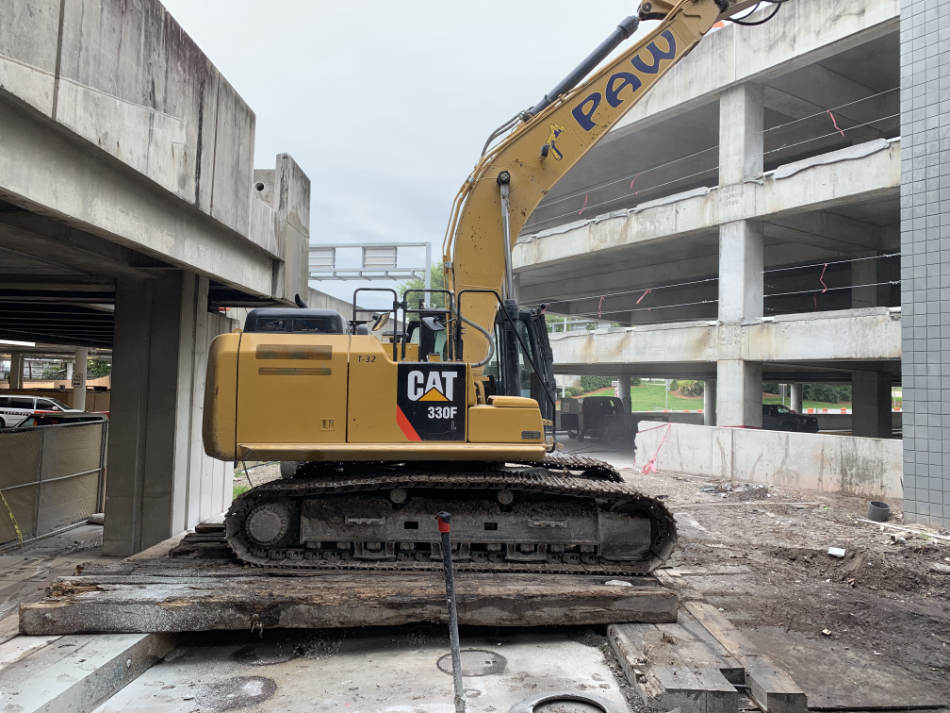Quick Answer:
A hydraulic excavator is a large construction machine that relies on hydraulic power to operate its moving parts. With its powerful system of pumps, cylinders, and fluid pressure, it can dig, lift, and move materials with exceptional strength and accuracy.
The machine is built on a chassis with either tracks or wheels, topped by an upper structure that houses the engine and operator’s cab. Attached to this are the boom, arm, and bucket, which work together to tackle demanding tasks in construction, mining, and major infrastructure projects.
What Is a Hydraulic Excavator?
A hydraulic excavator is a piece of construction equipment that uses hydraulic fluid under pressure to power its movements. Unlike older cable-operated machines, hydraulic excavators deliver greater power, smoother operation, and precise control.
In Florida, they are the machine of choice for commercial demolition in Tampa, site preparation, and large-scale infrastructure projects.
Micro Q&A
Q: Why are hydraulic excavators more efficient than cable excavators?
A: Hydraulic systems provide more force and precise control, which makes them ideal for heavy demolition and detailed excavation work.
Main Components of a Hydraulic Excavator
Hydraulic excavators are built from several key parts, each playing a critical role in performance:
-
Boom: The long arm that extends upward and outward.
-
Stick/Arm: Connects the boom to the bucket, providing reach.
-
Bucket: Used for digging, scooping, or demolition.
-
Cab: Where the operator controls the machine.
-
Undercarriage: Tracks or wheels that move the excavator.
-
Hydraulic System: Pumps, valves, and cylinders that drive motion.
On large infrastructure sites like Lakeland bridge and highway projects, these components are pushed to the limit daily.
Micro Q&A
Q: Can you swap out excavator attachments?
A: Yes, attachments like hydraulic breakers, grapples, and shears can be added for specialized demolition tasks.

Safe, efficient teardown services backed by 30+ years of local experience.
Common Uses of Hydraulic Excavators in Florida
Hydraulic excavators are versatile machines found on nearly every type of construction site. In Florida, their most common uses include:
-
Commercial demolition: Breaking down structures in cities like Lakeland, Clearwater, and Wesley Chapel.
-
Earthmoving: Excavating soil for new residential or industrial developments.
-
Road and bridge work: Essential in highway demolition and bridge removal projects.
-
Utility projects: Digging trenches for underground water and sewer lines.
-
Concrete breaking: Using hydraulic hammers to dismantle foundations.
For a real example, see how our team handles commercial demolition in Lakeland with specialized excavator equipment.
Micro Q&A
Q: Are hydraulic excavators only for demolition?
A: No, they are also used for digging, lifting, grading, and loading material on construction projects.
Hydraulic Excavator vs Backhoe vs Bulldozer
Contractors in Florida often compare different machines for the job. Here’s how excavators stack up:
| Machine | Best For | Size/Reach | Common Florida Use |
|---|---|---|---|
| Hydraulic Excavator | Demolition, heavy digging | Large, deep reach | Commercial building removal, bridge demolition |
| Backhoe | Light excavation, utility work | Smaller, versatile | Residential trenching, landscaping |
| Bulldozer | Pushing, grading | Wide blade, no digging | Land clearing, road base preparation |
If your project involves controlled structural takedowns, an excavator is usually the best choice.
Why Excavators Are Essential in Florida Demolition
Hydraulic excavators are a critical part of Florida’s demolition industry because they provide:
-
Raw power to break reinforced concrete and steel.
-
Extended reach for high structures in urban areas.
-
Speed and efficiency that reduce overall project timelines.
-
Operator safety with remote and precision controls.
These advantages make them the go-to choice for commercial demolition in Clearwater and other fast-growing Florida cities.
Micro Q&A
Q: Do hydraulic excavators help with safety on site?
A: Yes, their precision allows controlled demolition, reducing risks for workers.
FAQ: Hydraulic Excavators
Q: How much does a hydraulic excavator weigh?
A: Compact models start around 3 tons, while large demolition excavators can exceed 90 tons.
Q: What fuel do hydraulic excavators use?
A: Most run on diesel engines for maximum torque and reliability.
Q: Are hydraulic excavators useful for residential demolition?
A: Yes, smaller excavators are often used in residential demolition projects across Florida.
Q: How long can a hydraulic excavator last?
A: With proper maintenance, 7,000 to 10,000 operating hours or more.
Q: How much does it cost to rent a hydraulic excavator in Florida?
A: Rental rates vary by size, but most range between $300 and $1,500 per day.
People Also Ask
What size excavator is best for commercial demolition in Florida?
Mid-sized buildings often use 30 to 50-ton excavators, while large-scale projects require 80-ton models or larger.
Can hydraulic excavators be used for water reclamation projects?
Yes, they are frequently used in water reclamation projects in Spring Hill and other parts of Florida.
What is the difference between a backhoe and a hydraulic excavator?
A backhoe is smaller and good for light excavation, while an excavator is stronger and more suited for demolition and heavy lifting.
Do Florida demolition contractors provide excavator services?
Yes, many companies provide equipment and operators. You can request services directly through a demolition service provider.
Call to Action
Need heavy-duty demolition services with hydraulic excavators in Florida? Our experienced team has handled everything from Tampa International Airport projects to local commercial demolitions.
Get a free quote today or contact our team to schedule your project.

